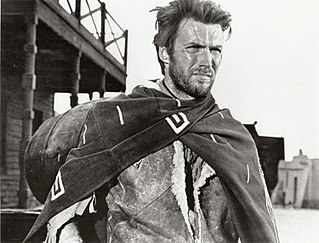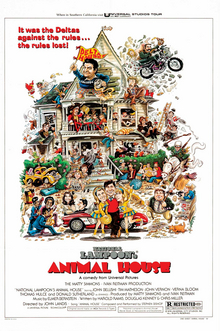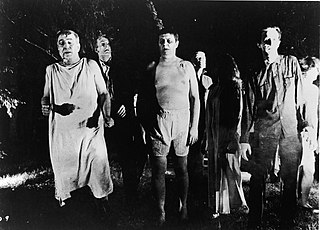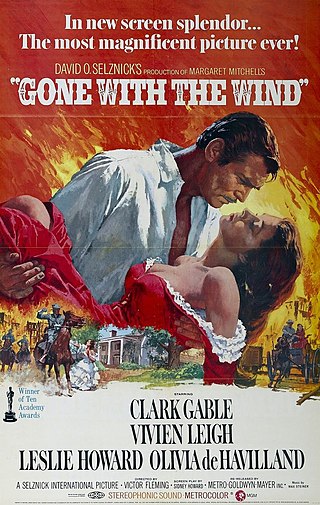Related Research Articles

A comedy film is a category of film that emphasizes humor. These films are designed to amuse audiences and make them laugh. Films in this genre typically have a happy ending, with dark comedy being an exception to this rule. Comedy is one of the oldest genres in film, and it is derived from classical comedy in theatre. Some of the earliest silent films were comedies such as slapstick comedy, which often relies on visual depictions, such as sight gags and pratfalls, so they can be enjoyed without requiring sound. To provide drama and excitement to silent movies, live music was played in sync with the action on the screen, on pianos, organs, and other instruments. When sound films became more prevalent during the 1920s, comedy films grew in popularity, as laughter could result from both burlesque situations but also from humorous dialogue.

A cult film or cult movie, also commonly referred to as a cult classic, is a film that has acquired a cult following. Cult films are known for their dedicated, passionate fanbase which forms an elaborate subculture, members of which engage in repeated viewings, dialogue-quoting, and audience participation. Inclusive definitions allow for major studio productions, especially box-office bombs, while exclusive definitions focus more on obscure, transgressive films shunned by the mainstream. The difficulty in defining the term and subjectivity of what qualifies as a cult film mirror classificatory disputes about art. The term cult film itself was first used in the 1970s to describe the culture that surrounded underground films and midnight movies, though cult was in common use in film analysis for decades prior to that.

A film genre is a stylistic or thematic category for motion pictures based on similarities either in the narrative elements, aesthetic approach, or the emotional response to the film.

Annie Hall is a 1977 American satirical romantic comedy-drama film directed by Woody Allen from a screenplay written by Allen and Marshall Brickman, and produced by Allen's manager, Charles H. Joffe. The film stars Allen as Alvy Singer, who tries to figure out the reasons for the failure of his relationship with the eponymous female lead, played by Diane Keaton in a role written specifically for her.

National Lampoon's Animal House is a 1978 American comedy film directed by John Landis and written by Harold Ramis, Douglas Kenney and Chris Miller. It stars John Belushi, Tim Matheson, John Vernon, Verna Bloom, Thomas Hulce and Donald Sutherland. The film is about a trouble-making fraternity whose members challenge the authority of the dean of the fictional Faber College.

A B movie, or B film, is a type of low-budget commercial motion picture. Originally, during the Golden Age of Hollywood, this term specifically referred to films meant to be shown as the lesser-known second half of a double feature, somewhat similar to B-sides in the world of recorded music. However, the production of such films as "second features" in the United States largely declined by the end of the 1950s. This shift was due to the rise of commercial television, which prompted film studio B movie production departments to transition into television film production divisions. These divisions continued to create content similar to B movies, albeit in the form of low-budget films and series.

Scary Movie is a 2000 American slasher parody film directed by Keenen Ivory Wayans and written by Marlon and Shawn Wayans, alongside Buddy Johnson, Phil Beauman, Jason Friedberg and Aaron Seltzer. Starring Jon Abrahams, Carmen Electra, Shannon Elizabeth, Anna Faris, Kurt Fuller, Regina Hall, Lochlyn Munro, Cheri Oteri, and Dave Sheridan, it follows a group of teenagers who accidentally hit a man with their car, dump his body in a lake, and swear to secrecy. A year later, someone wearing a Ghostface mask and robe begins hunting them one by one.
Teen film is a film genre targeted at teenagers, preteens and/or young adults by the plot being based on their special interests, such as coming of age, attempting to fit in, bullying, peer pressure, first love, teen rebellion, conflict with parents, and teen angst or alienation. Often these normally serious subject matters are presented in a glossy, stereotyped or trivialized way. Many teenage characters are portrayed by young adult actors in their 20s. Some teen films appeal to young males, while others appeal to young females.

An art film, art cinema, or arthouse film, is typically an independent film, aimed at a niche market rather than a mass market audience. It is "intended to be a serious, artistic work, often experimental and not designed for mass appeal", "made primarily for aesthetic reasons rather than commercial profit", and containing "unconventional or highly symbolic content".

An exploitation film is a film that tries to succeed financially by exploiting current trends, niche genres, or lurid content. Exploitation films are generally low-quality "B movies", though some set trends, attract critical attention, become historically important, and even gain a cult following.

Mr. Mike's Mondo Video is a 1979 American comedy film conceived and directed by Saturday Night Live writer/featured player Michael O'Donoghue. It is a spoof of the controversial 1962 documentary Mondo Cane, showing people doing weird stunts.

Off-color humor is humor that deals with topics that may be considered to be in poor taste or vulgar. Many comedic genres may incorporate "off-color" elements.

The beach party film is an American film genre of feature films which were produced and released between 1963 and 1968, created by American International Pictures (AIP), beginning with their surprise hit, Beach Party, in July 1963. With this film, AIP is credited with creating the genre. In addition to the AIP films, several contributions to the genre were produced and released by major and independent studios alike. According to various sources, the genre comprises over 30 films, with the lower-budget AIP films being the most profitable.

Terror Train is a 1980 slasher film directed by Roger Spottiswoode in his directorial debut and starring Jamie Lee Curtis, Ben Johnson, and Hart Bochner. The film follows a group of pre-medical school students holding a New Year's Eve costume party on a moving train who are targeted by a killer who dons their costumes. It features supporting performances from Sandee Currie, Anthony Sherwood, and David Copperfield.

Comedy horror, also known as horror comedy, is a literary, television, and film genre that combines elements of comedy and horror fiction. Comedy horror has been described as able to be categorized under three types: "black comedy, parody and spoof." It often crosses over with the black comedy genre. Comedy horror can also parody or subtly spoof horror clichés as its main source of humour or use those elements to take a story in a different direction. Examples of comedy horror films include Abbott and Costello Meet Frankenstein (1948), An American Werewolf in London (1981), the Evil Dead franchise (1981–present), Gremlins (1984), Shaun of the Dead (2004), and The Cabin in the Woods (2011).

Extreme cinema is a subgenre used for films distinguished by its use of excessive sex and violence, and depiction of extreme acts such as mutilation and torture. It recently specializes in genre film, mostly both horror and drama.
Sex comedy, erotic comedy or more broadly sexual comedy is a genre in which comedy is motivated by sexual situations and love affairs. Although "sex comedy" is primarily a description of dramatic forms such as theatre and film, literary works such as those of Ovid and Geoffrey Chaucer may be considered sex comedies.

Comedy is a genre of fiction that consists of discourses or works intended to be humorous or amusing by inducing laughter, especially in theatre, film, stand-up comedy, television, radio, books, or any other entertainment medium. The term originated in ancient Greece: In Athenian democracy, the public opinion of voters was influenced by political satire performed by comic poets in theaters. The theatrical genre of Greek comedy can be described as a dramatic performance pitting two groups, ages, genders, or societies against each other in an amusing agon or conflict. Northrop Frye depicted these two opposing sides as a "Society of Youth" and a "Society of the Old". A revised view characterizes the essential agon of comedy as a struggle between a relatively powerless youth and the societal conventions posing obstacles to his hopes. In this struggle, the youth then becomes constrained by his lack of social authority, and is left with little choice but to resort to ruses which engender dramatic irony, which provokes laughter.

In film and television, drama is a category or genre of narrative fiction intended to be more serious than humorous in tone. The drama of this kind is usually qualified with additional terms that specify its particular super-genre, macro-genre, or micro-genre, such as soap opera, police crime drama, political drama, legal drama, historical drama, domestic drama, teen drama, and comedy-drama (dramedy). These terms tend to indicate a particular setting or subject matter, or they combine a drama's otherwise serious tone with elements that encourage a broader range of moods. To these ends, a primary element in a drama is the occurrence of conflict—emotional, social, or otherwise—and its resolution in the course of the storyline.
American comedy films are comedy films produced in the United States. The genre is one of the oldest in American cinema; some of the first silent movies were comedies, as slapstick comedy often relies on visual depictions, without requiring sound. With the advent of sound in the late 1920s and 1930s, comedic dialogue rose in prominence in the work of film comedians such as W. C. Fields and the Marx Brothers. By the 1950s, the television industry had become serious competition for the movie industry. The 1960s saw an increasing number of broad, star-packed comedies. In the 1970s, black comedies were popular. Leading figures in the 1970s were Woody Allen and Mel Brooks. One of the major developments of the 1990s was the re-emergence of the romantic comedy film. Another development was the increasing use of "gross-out humour".
References
- ↑ Eyman, Louis Giannetti, Scott (2010). Flashback : a brief history of USA (6th ed.). Boston, MA: Pearson Education/Allyn & Bacon. p. 379. ISBN 978-0-205-69590-4.
{{cite book}}: CS1 maint: multiple names: authors list (link) - ↑ Pryor], Joe Garner ; foreword by Richard (2004). Made you laugh! : the funniest moments in radio, television, stand-up, and movie comedy. Kansas City: Andrews McMeel Pub. p. 171. ISBN 0-7407-4695-2.
{{cite book}}: CS1 maint: multiple names: authors list (link) - ↑ Capsuto, Steven (2000). Alternate channels : the uncensored story of gay and lesbian images on radio and television (1. ed.). New York, NY: Ballantine Books. pp. 250. ISBN 0-345-41243-5.
- ↑ King, Geoff (2002). Film comedy (repr. ed.). London [u.a.]: Wallflower. pp. 73. ISBN 1-903364-35-3.
- 1 2 3 4 Mitchell, Elvis (25 August 2003). "Revisiting Faber College (Toga, Toga, Toga!)". The New York Times . Retrieved 2011-01-28.
- ↑ Bernheimer, Kathryn (1999). The 50 funniest movies of all time : a critic's ranking. Secaucus, N.J.: Carol Pub. Group. pp. 109–111. ISBN 0-8065-2091-4.
- ↑ komedykollective.com